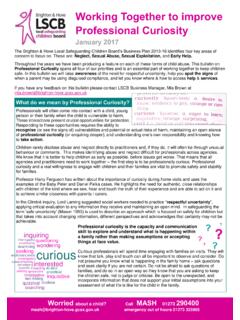Transcription of A brief guide to challenging sexist and sexual language ...
1 Version 1 January 2017 1 Developed by Brighton & Hove s Equality and Anti-Bullying Schools Strategy Group, 2016 please feedback suggestions for improvements to A brief guide to challenging sexist and sexual language and bullying Context Nationally and locally there are concerns being raised about sexism and sexual bullying in educational settings. For example: nearly three-quarters (71%) of all 16-18 year old boys and girls say they hear terms such as "slut" or "slag" used towards girls at schools on a regular basis 59% of girls and young women aged 13-21 said in 2014 that they had faced some form of sexual harassment at school or college in the past year ( sexual harassment and sexual violence in schools Report of the Women and Equalities Committee, 2016) Whole school approaches to challenging and preventing sexism and promoting gender equality are needed to ensure that we take sexism as seriously as other forms of prejudice such as racism or homophobia.
2 This guide focuses on one aspect of this work to improve gender equality. Purpose of guide Sexism includes: attitudes or behaviour based on rigid adherence to traditional stereotypes of gender roles which limit choice, opportunities and freedom discrimination or devaluation based on a person's sex or gender, viewing one sex (usually female) as inferior to another ingrained and institutionalised prejudice against or hatred of women (misogyny). Boys and men are also negatively affected by gender stereotyping, often as a result of the view that to have feminine attributes is to be lesser and weaker. This guide has been written by the Equality and Anti-Bullying Schools Strategy Group and informed by focus groups with young people with the purpose of supporting staff to appropriately challenge sexist and sexual language and gender stereotyping. language and terminology are changeable and contested, but reflecting on when and how we and others use language is an important aspect of professional development and acknowledges the influence adults have on pupils and students in educational settings.
3 In the writing of this guide we are aware that there is a spectrum of gender identity and that gender is wider than the binary of boys and girls and males and females. This is one of the reasons why gender stereotyping is unhelpful and damaging as sexism leads us to believe that boys and girls should present themselves in certain ways. Transphobia and homophobia can result from this. However, the focus of this guide is on identifying and challenging sexism, gender stereotyping and sexist and sexual language to prevent negative impacts on the wellbeing and aspirations of girls and young women. Version 1 January 2017 2 Developed by Brighton & Hove s Equality and Anti-Bullying Schools Strategy Group, 2016 please feedback suggestions for improvements to Questions to ask yourself No-one is prejudice free and for this reason it is important to continually reflect on practice and any unintentional or unconscious bias we may be reinforcing. Do you unintentionally reinforce bias or gender stereotyping, for example, by allowing louder behaviours in boys than girls?
4 Are you more understanding of boys anger, but less so when it is displayed by girls? Are you understanding of boys who cry? Is there anything about your classroom organisation or curriculum content that might reinforce gender stereotypes are there boys books or just male scientists displayed? How do you line up pupils or dismiss students from class. Does this have to be by gender? Do you speak differently to boys and girls? Are sanctions different for boys and girls? Are they fair? Do boys speak more in class discussion than the girls? Or get more attention and time? Can you think of any books (or other resources) that you have used that challenge gender stereotypes? What other things could you do to make children and young people more aware that we can all do anything and that we need never feel constrained by our gender? Adapted from What sexist and gender stereotypical language and behaviour looks like and sounds like and ways to respond 1 sexual assault Without consent, everything from skirt lifting, bra strap snapping through to touching of breasts, buttocks and genitals and rape is sexual assault.
5 It should be treated seriously and both sets of parents or carers should be informed. In addition to school sanctions, social services or police should be informed as appropriate. 2 Abusive, insulting or sexualised language Terms such as slag, sket, whore and bitch are used to demean girls and women. This includes use of words to describe women s genitalia as terms of abuse. These terms should be treated as seriously as racist or homophobic language . This language along with sexist or sexualised insults about clothing, body shape or related to sexual activity should be treated as unacceptable within educational settings. As with other forms of prejudicial language , sexist language is not always intended to hurt, but it will still have a negative impact on all genders because of the unconscious bias or inequality it promotes. 3 sexist assumptions and stereotypes Only boys or girls are better at . This can include attitudes such as women being too easily offended, girls or women being bossy rather than assertive.
6 This can be responded to by pointing out role models who counter these stereotypes or by asking where these ideas come from Who Care needs to be taken to challenge what is termed as banter or jokes at the expense of women or girls. Suggestions that females are inferior to males or that they should have a subordinate role should always be challenged by reference to equalities law. 4 Benevolent sexism Chivalrous attitudes to girls and women that appear positive and favourable, but are based on women being weaker , needing protection, and can include complimenting pupils based on gendered stereotypes should be avoided or challenged when heard. However, this does not mean that we do not encourage all children and young people to be polite, kind and respectful to all. Version 1 January 2017 3 Developed by Brighton & Hove s Equality and Anti-Bullying Schools Strategy Group, 2016 please feedback suggestions for improvements to 5 Using girl as an insult or being told to man up Phrases like crying (or throwing) like a girl imply that girls are physically and emotionally weak.
7 Similarly telling someone to man up or grow a pair assumes courage, strength and determination are male characteristics. Find non-gendered alternatives Dig deep . 6 Gendered language The English language appears to have evolved on the assumption that the world is male: the man in the street , manning the phones , the tax man and so on. This language can make girls feel their contribution to society is invisible or useless. Counter this with appropriate alternatives such as police officer or fire fighter. It is important to remember that whilst many of the words used to describe men are positive, words used to describe women often have negative connotations. Examples here include bachelor and spinster; sir and madam. Some insults directed towards men make reference to women ( old woman , son-of-bitch ). school staff can take care with how they use gendered language . For example: I am looking for two strong boys to volunteer to move the tables . Using non-gendered language such as students, people or folk would be preferable.
8 Avoid making assumptions about who is at home or who may perform certain tasks in the home. 7 Historical, dated language and devaluing terminology Some of the language used in schools implies a difference of status and its use could be reflected on. For example, Miss and Sir or the use of Ladies and Gentlemen. Adult females should be referred to as women not girls. Terms of endearment and how they are received could differ according to regional or class differences, but should be used with care because of the implicit messages that could be given. 8 Talking about school uniform There has been a lot of recent media discussion about school responses to girls wearing short skirts. Whilst schools have every right to enforce school uniform policy some of the language used to do this has implied that by wearing short skirts girls are then responsible for the sexual abuse or harassment that they receive. Therefore staff need to find language which encourages compliance with the uniform policy , but without implying that what someone wears can make them responsible for any verbal or other abuse.
9 Schools should therefore adopt a clear script for staff to use to enforce this and potentially other parts of the policy . For example: At our school we dress for business / learning and so we require clothing which is in keeping with this. We have a uniform policy that supports a professional approach to learning, and prepares students for the workplace, what you are wearing is not in keeping with this policy . Uniform and make-up policies should be equally applied to all genders. PSHE can additionally be used to explore the right all people have to wear the clothing they want to (be it headscarves or short skirts) without being abused or fearful of being abused and to explore media representations of women. 9 challenging or responding to our colleagues challenging our peers or managers can be a really challenging thing to do as we will be keen to maintain a working relationship. Speaking with another colleague or line manager and practicing a response may be helpful before having a conversation with a colleague who you think has made a prejudiced remark.
10 Having a stock response But not all girls / may be helpful and in the case of serious incidents these will need to be referred to a more senior member of staff to consider in relation to the Dignity at Work or other staff policy . Version 1 January 2017 4 Developed by Brighton & Hove s Equality and Anti-Bullying Schools Strategy Group, 2016 please feedback suggestions for improvements to Principles for challenging Scripts or prompts for challenging - Preventing and responding to bullying should be seen as one overarching process effective responses inform effective prevention work. - Make effective use of the curriculum to prevent sexist , sexual , homophobic and transphobic bullying, and address some of the underlying attitudes that may underpin these forms of bullying. - Ensure you are aware of school policy and record sexist and sexual bullying and incidents - Escalate including involving the Police and Social Services in serious incidents and always when a crime is alleged - Be firm and clear about diversity and equal rights and what is not acceptable - Be prepared to challenge sexism by reference to equality and human rights laws - including if the pupil or student uses tradition, culture or religion to justify inequality - Explain clearly and assertively why sexist and sexualised language is inappropriate and damaging both to individuals and for all in a school community - Challenge all incidents.



